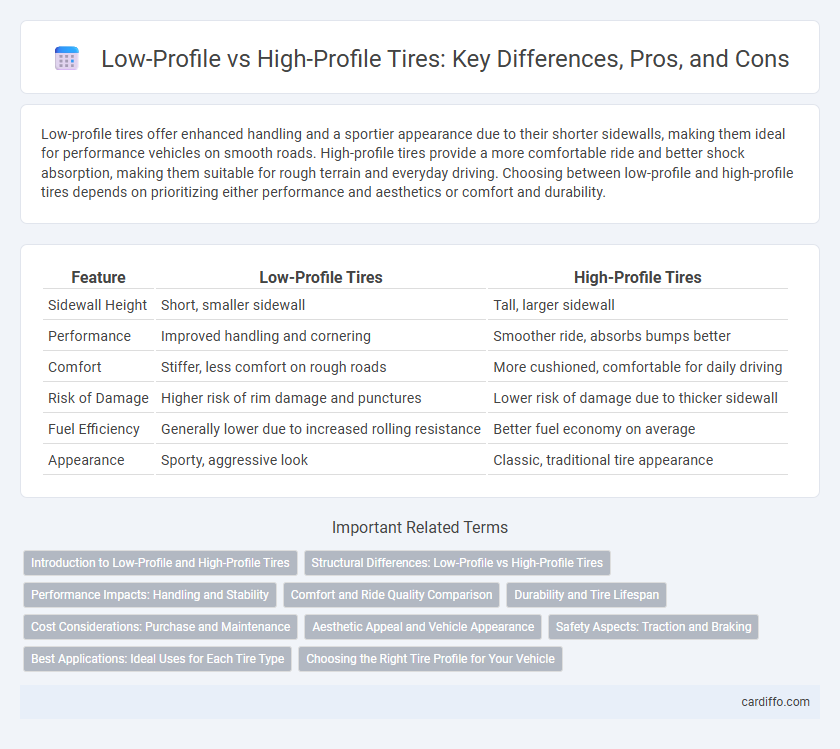Low-profile tires offer enhanced handling and a sportier appearance due to their shorter sidewalls, making them ideal for performance vehicles on smooth roads. High-profile tires provide a more comfortable ride and better shock absorption, making them suitable for rough terrain and everyday driving. Choosing between low-profile and high-profile tires depends on prioritizing either performance and aesthetics or comfort and durability.
Table of Comparison
| Feature | Low-Profile Tires | High-Profile Tires |
|---|---|---|
| Sidewall Height | Short, smaller sidewall | Tall, larger sidewall |
| Performance | Improved handling and cornering | Smoother ride, absorbs bumps better |
| Comfort | Stiffer, less comfort on rough roads | More cushioned, comfortable for daily driving |
| Risk of Damage | Higher risk of rim damage and punctures | Lower risk of damage due to thicker sidewall |
| Fuel Efficiency | Generally lower due to increased rolling resistance | Better fuel economy on average |
| Appearance | Sporty, aggressive look | Classic, traditional tire appearance |
Introduction to Low-Profile and High-Profile Tires
Low-profile tires feature a shorter sidewall height relative to their width, enhancing vehicle handling and providing a sporty appearance. High-profile tires have taller sidewalls, offering increased comfort and better absorption of road irregularities. Choosing between these tire types depends on driving preferences, road conditions, and vehicle requirements.
Structural Differences: Low-Profile vs High-Profile Tires
Low-profile tires feature shorter sidewalls and wider treads, enhancing cornering stability and providing a sportier ride, while high-profile tires have taller sidewalls that improve shock absorption and offer a more comfortable driving experience. The structural difference lies in the aspect ratio, with low-profile tires typically ranging from 30 to 50, compared to high-profile tires that exceed 60, affecting the tire's flexibility and overall durability. These distinctions influence vehicle handling, ride quality, and the tire's ability to withstand road impacts.
Performance Impacts: Handling and Stability
Low-profile tires provide enhanced handling and stability by offering a larger contact patch and stiffer sidewalls, which improve cornering precision and responsiveness. High-profile tires, with their taller sidewalls, absorb road irregularities better, resulting in a smoother ride but less sharp handling. Drivers seeking performance benefits typically prefer low-profile tires for better control at higher speeds, while high-profile tires favor comfort and durability over aggressive driving dynamics.
Comfort and Ride Quality Comparison
Low-profile tires feature shorter sidewalls that enhance steering response but tend to transmit more road imperfections, resulting in a firmer ride. High-profile tires have taller sidewalls that provide better shock absorption and improved cushioning, leading to increased comfort over rough or uneven surfaces. Drivers seeking superior ride quality typically prefer high-profile tires for their enhanced ability to absorb bumps and reduce vibration.
Durability and Tire Lifespan
Low-profile tires typically have stiffer sidewalls, which improve handling but can lead to increased wear and a shorter lifespan compared to high-profile tires. High-profile tires offer greater durability due to their thicker sidewalls, better absorbing road impacts and reducing tire damage over time. This results in longer tire lifespan for high-profile tires, especially on rough or uneven surfaces.
Cost Considerations: Purchase and Maintenance
Low-profile tires generally have a higher purchase price due to advanced materials and complex manufacturing processes, while high-profile tires tend to be more affordable upfront. Maintenance costs for low-profile tires increase as they are more susceptible to damage from potholes and curbs, requiring frequent repairs or replacements. Conversely, high-profile tires offer greater durability and cushioning, leading to lower long-term maintenance expenses.
Aesthetic Appeal and Vehicle Appearance
Low-profile tires enhance vehicle appearance by providing a sportier and more aggressive look, often making the wheels appear larger and filling the wheel wells more effectively. High-profile tires contribute to a classic and rugged aesthetic, emphasizing comfort and durability with a taller sidewall that complements off-road or vintage vehicle designs. Choosing between low-profile and high-profile tires significantly impacts the overall visual impression, aligning with either performance-oriented or traditional styling preferences.
Safety Aspects: Traction and Braking
Low-profile tires offer improved traction and braking performance on dry roads due to their larger contact patch and stiffer sidewalls, enhancing vehicle stability during cornering and sudden stops. High-profile tires, with their taller sidewalls, provide better shock absorption and maintain traction on uneven or slippery surfaces, reducing the risk of hydroplaning in wet conditions. Choosing the appropriate tire profile depends on driving environment and safety priorities, balancing responsiveness with comfort and grip under varying road conditions.
Best Applications: Ideal Uses for Each Tire Type
Low-profile tires excel in performance vehicles where improved handling, sharper steering response, and enhanced road grip are essential, making them ideal for sports cars and street racing. High-profile tires offer superior comfort and better shock absorption on rough or uneven terrain, making them best suited for off-road vehicles, SUVs, and trucks frequently driven on gravel or dirt roads. Choosing between low-profile and high-profile tires depends on driving conditions, with low-profile favoring smooth pavement and high-profile providing durability for rugged environments.
Choosing the Right Tire Profile for Your Vehicle
Choosing the right tire profile for your vehicle depends on driving style, road conditions, and performance needs. Low-profile tires offer enhanced handling and a sportier appearance, ideal for smooth roads and aggressive driving, while high-profile tires provide better comfort and shock absorption on rough or uneven surfaces. Balance factors like ride comfort, tire durability, and aesthetics to select the optimal tire profile for safety and performance.
Low-profile tires vs High-profile tires Infographic

 cardiffo.com
cardiffo.com